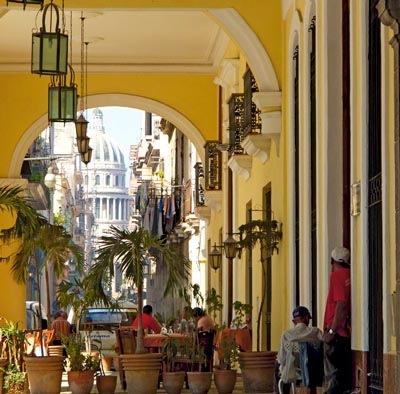Cuba opens doors to travellers
From Hemingway's Havana to the old sugar-baron houses of Trinidad, Cuba is slowly opening up her doors to the modern traveller. Go now, advises Chris Caldicott


The ground floor of the restaurant, like so much of Cuba, looked like the set of a post-apocalyptic disaster film. The crumbling stairway swept upwards from the once-elegant but now peeling Italianate loggia to a modest doorway. Finally, there was a sign that confirmed that this was indeed the location of the most talked about culinary experience in Havana: the Paladar La Guarida.
It's an eclectic feast of English dinner services, Venetian glassware, Catholic effigies, Art Deco lamps and contemporary Cuban art, where the customers look as cool as the decor. What's more, the food is sensational-a statement that wouldn't have been applied to many places in Cuba when I first came here 20 years ago. Much has changed since then, and almost all of it for the better. Cuba is on the move and there has never been a better time to visit.
This time, I had signed up for a bespoke tour with Cuban specialist Esencia. Despite many liberalisations, any traveller to Cuba can still be a victim of vague uncertainties, but the company boasts a team of charmingly efficient, English-speaking local fixers. Whatever your passion, from opera to salsa, ballet to rumba, abstract art to Caravaggio, they'll arrange the best experience possible.
From the airport, a waiting car whisked me off to the Hotel Santa Isabel, a splendid colonial-era house in the heart of Habana Vieja (Old Town)-a perfect base from which to explore Havana's attractions on foot. However, taking advantage of the car and its driver, I soon ventured further afield in search of fine food, architectural gems, unspoilt beaches and live music.
Cuba's music scene is thrillingly diverse. Visitors can choose from the spectacular, Busby Berkeley-style dance routines at the Tropicana Club, the serious folkloric ensemble of Afro-Cuban dance at the Conjunto Folklórico de Camaguey, the soothing retro rhythms of the Buena Vista Social Club-style Compay Segundo band at the Hotel Nacional or a world-class performance of Giselle by the Ballet Nacional de Cuba in the gorgeously opulent neo-Baroque Gran Teatro de la Habana.
However, my fondest memories are of musicians randomly selected with the help of my Esencia music specialist, who provided me with nightly listings of who was playing where in the city's smaller venues.

Recently, Havana's paladares (pop-up restaurants in private homes) have been allowed to expand in size and use previously forbidden ingredients such as fresh lobster and beef. La Guardia has many imitators, creating an adventurous style of fusion cooking that blends traditional Cuban dishes with other influences to create Nueva Cocina Cubana. New ones appear every week, long before they're listed in any guidebook.
Exquisite houses, the beauty of Nature, and how to get the most from your life, straight to your inbox.
I found this culinary renaissance just as evident in Trinidad on Cuba's Caribbean coast. Far from being smug about its UNESCO status, the town offers a friendly welcome full of timeless charm, as if the clocks stopped 150 years ago when the sugar barons were making their fortunes. The colonial mansions and former ecclesiastical edifices are now museums, and Trinidad is in the grip of restoration fever, producing a fresh crop of wonderful casas particulares (Cuban home-stays) and paladares.
One of the newest paladares, named 1514, is the ultimate expression of everything that makes Cuba such a special destination: antique elegance, delicious local cuisine and a group of resident musicians who capture the romance of a bygone era.
The majority of the cars on Cuba's empty roads are still magnificently nostalgic remnants of the glory days of 1950s American gas-guzzlers. Most are run by the state as colectivos, providing cheap transport for local people. Some are private taxis, and the most impressive of them, like the immaculate 1956 red Oldsmobile convertible hired for my half-day Hemingway Tour back in Havana, are used on tourist trips.
We drove on with the roof down in the Caribbean sunshine, feeling like film stars, to the fishing village of Cojimar, famous as the setting of The Old Man and the Sea. We then called in at the beautiful old villa nearby where Hemingway used to live on the way back to Havana to raise glasses of mojitos and daiquiris in his memory at his favourite haunts of La Bodeguita del Medio, El Floridita and Ambos Mundos.
Like La Guarida, if you know how to find them behind the spectacular dilapidation, Cuba can offer great rewards. Chris Calidcott travelled with Esencia Experiences. Its Havana and Trinidad trip costs from £1,999 per person, including flights, visas, VIP arrival, five-star hotel (on a bed and breakfast basis), an English-speaking driver with an air-conditioned car, and full, on-the-ground concierge booking service (01481 714898; www.esenciaexperiences.com)
to Country Life and save over £50 a year
Country Life is unlike any other magazine: the only glossy weekly on the newsstand and the only magazine that has been guest-edited by His Majesty The King not once, but twice. It is a celebration of modern rural life and all its diverse joys and pleasures — that was first published in Queen Victoria's Diamond Jubilee year. Our eclectic mixture of witty and informative content — from the most up-to-date property news and commentary and a coveted glimpse inside some of the UK's best houses and gardens, to gardening, the arts and interior design, written by experts in their field — still cannot be found in print or online, anywhere else.
